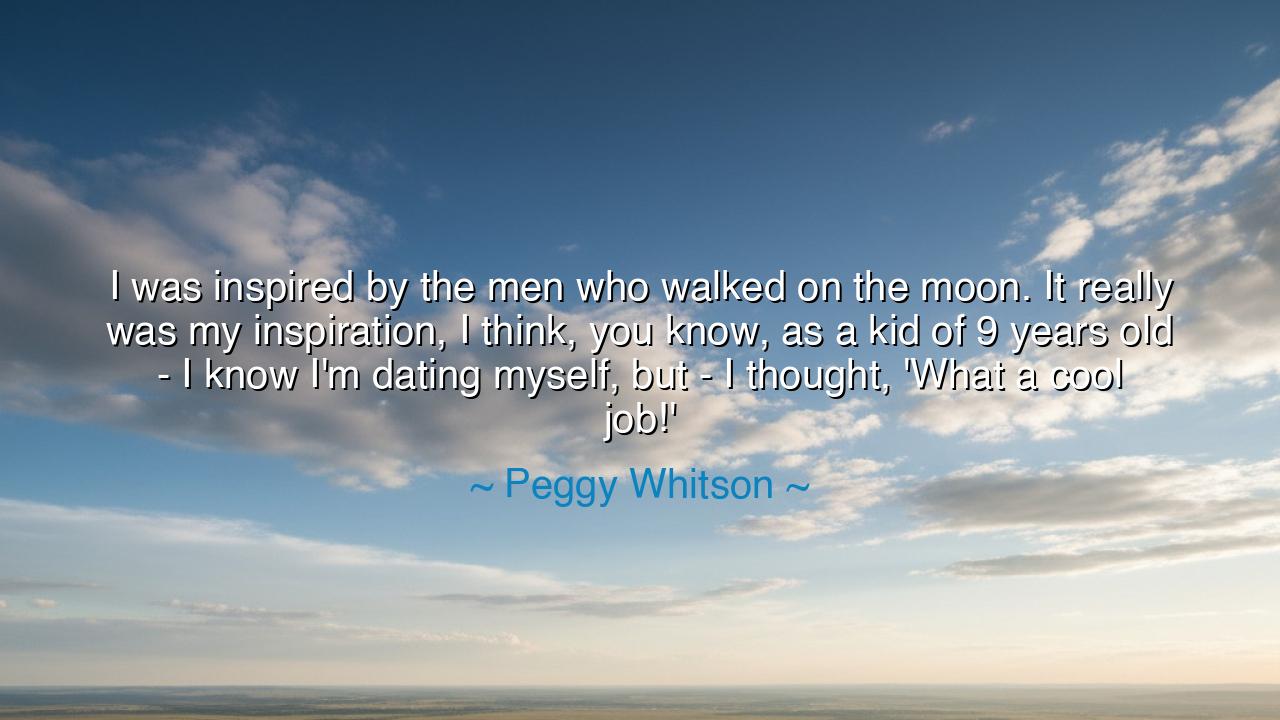
I was inspired by the men who walked on the moon. It really was
I was inspired by the men who walked on the moon. It really was my inspiration, I think, you know, as a kid of 9 years old - I know I'm dating myself, but - I thought, 'What a cool job!'






In the scroll of human longing, a bright line is inked by a child who looks up. So speaks Peggy Whitson: “I was inspired by the men who walked on the Moon. It really was my inspiration, I think, you know, as a kid of 9 years old—I know I'm dating myself, but—I thought, ‘What a cool job!’ ” Hear the small thunder inside those words. A living flame leaps from the Apollo fires into the lantern of a young mind; wonder becomes a vow. The saying is not merely memory—it is a charter for how visions travel: from distant footprints in lunar dust to quiet decisions at a kitchen table, from televised glory to the steady, daily grind that carries someone skyward.
To grasp her meaning, we must first honor the age she names: 9 years old—the tender gate where the world begins to divide into paths we might take. At that gate, the Moon was not a metaphor but a neighbor; the astronaut was not an abstraction but a possible self. She calls it a “cool job,” yet beneath the simplicity is a deep truth of the sages: naming a thing as desirable is the first rite of becoming. For many, inspiration is a spark that dies on the stone; for Whitson, it found dry wood—discipline, patience, and the long obedience of study—and grew into a hearth that would one day warm a whole generation.
Consider the origin of the vision she carried: the Apollo landings, when humanity’s breath fogged the visor of the unknown and the gray face of the Moon answered back with silence and welcome. The broadcasts stitched the globe into a single theater, and even the smallest hands felt larger holding a cereal spoon that, for a minute, was a rocket. From that theater, one girl in Iowa began to plot a pilgrimage—not of miles, but of mastery. Her quote remembers that liturgy: watch, wonder, decide. The decision is the turning of the soul’s rudder; it is the moment the star charts begin to matter.
The ancients tell us that destiny favors those who make daily offerings. Whitson’s offerings were years of chemistry, of NASA applications, of the unglamorous labors that polish a dream until it can bear the sun. And see how the child’s vow became the elder’s authority: she would go on to spend hundreds of days in orbit, to command the International Space Station, and to set records that made the sky feel nearer to the ground. Note the arc: a girl gazes at the men who walked on the Moon, and then a woman stands among the leaders of the spacefaring age—proof that inspiration, rightly husbanded, is not a feeling but a craft.
Place beside her tale another, to widen our faith. In a village far from launchpads, a boy watched a teacher launch a paper glider lit by the afternoon sun. He whispered, “What a cool job,” and he meant not flying but teaching. Years later he returned to that same classroom, chalk on his fingers like starlight on a sleeve, and he gave other children their first lesson in lift. Not every dream ascends by rocket; some dreams press seeds into soil, steady hands in surgery, or laws into books. The common thread endures: a child sees, names the good, and spends a life answering that first yes.
What wisdom, then, shall we send forward? First, that inspiration is a sacred guest—welcome it with attention, seat it with discipline. Second, that heroes light the path, but you must take the step. Third, that calling something “cool” is not trivial; it is the soul’s shorthand for meaning. Do not mock it; magnify it. Fourth, that the distance from kitchen-table dream to cosmic window is measured in problem sets, early mornings, and the stubborn joy of not quitting. The stars do not need our romance; they require our readiness.
Take now these practical actions as traveling provisions: (1) Write down the moment that first inspired you—date it, guard it, read it on gray days. (2) Choose one skill that your dream demands and practice it daily, however small the increment. (3) Seek mentors and models—watch how they fall and rise, and borrow their habits. (4) Build a community who will hold you to your vow when your strength thins. (5) Offer your own story to a younger soul; lend them your ladder as others lent you theirs. Do this, and the chain continues: a footprint becomes a fire, a broadcast becomes a banner, and a child who whispers “What a cool job” grows—slowly, surely—into the person who does it.






AAdministratorAdministrator
Welcome, honored guests. Please leave a comment, we will respond soon